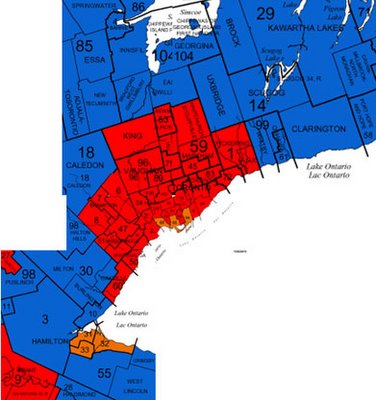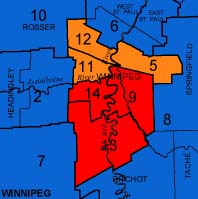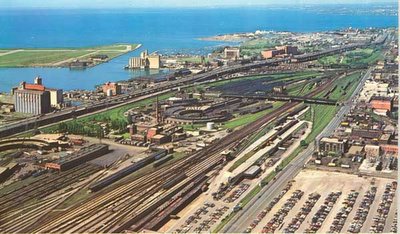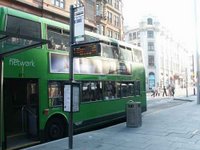I’ve been searching around for some truly inspiring and beautiful descriptions of the city in children’s literature. Why? Because if we don’t bring our children up to love the city, to appreciate what it is, what it can be, and to be interested in how the city can be improved without damaging its unique benefits, how can we expect them to grow up into people that will defend and care for the city that reared them? When 94% of all visible minorities in Canada live in “cities” (census metropolitan areas) of over 100,000 people, 79.4% of all Canadians live in cities of over 10,000, and 50% live in either the Toronto region, the Montreal region, the Vancouver region, or the Calgary-Edmonton corridor, and we are considered one of the world’s most urbanised countries, the lack of interest in what a livable, successful and vibrant city really is astounds me.
There are endless examples of wonderful descriptions of the landscape and country life in children’s literature, but where are the urban ones? Should we be worrying about how we are supporting the anglo-canadian tradition of the glorification of nature and the rural idyll, at the expense of our attitudes towards urban life? In some ways it’s a vicious cycle – our cities seem ugly and unimaginative and so people crave nature instead, but people too busy appreciating nature perhaps don’t have the effort or understanding left to care about the city enough to demand its improvement. Even our most famously beautiful city (Vancouver), derives the largest part of its aesthetic charm from the landscape rather than any innate beauty of the city itself.
So I’m launching a campaign to bring together a list of great urban children’s books. If you know of one, please leave a note to that effect in the comments area (end of the post) and I’ll compile whatever we get in a new post.
As an example of the problem, I’m posting a few quotes – gratuitously starting off with The Wind in the Willows and one of the great descriptions of the English countryside.
“It all seemed too good to be true. Hither and thither through the meadows he rambled busily, along the hedgerows, across the copses, finding everywhere birds building, flowers budding, leaves thrusting – everything happy, and progressive, and occupied…
He thought his happiness was complete when, as he meandered aimlessly along, suddenly he stood by the edge of a full-fed river. Never in his life had he seen a river before – this sleek, sinuous, full-bodied animal, chasing and chuckling, gripping things with a gurgle and leaving them with a laugh, to fling itself on fresh playmates that shook themselves free, and were caught and held again. All was a-shake and a-shiver – glints and gleams and sparkles, rustle and swirl, chatter and bubble. The Mole was bewitched, entranced, fascinated. By the side of the river he trotted as one trots, when very small, by the side of a man who holds one spell-bound by exciting stories; and when tired at last, he sat on the bank, while the river still chattered on to him, a babbling procession of the best stories in the world, sent from the heart of the earth to be told at last to the insatiable sea…
Leaving the main stream, they now passed into what seemed at first sight like a little land-locked lake. Green turf sloped down to either edge, brown snaky tree-roots gleamed below the surface of the quiet water, while ahead of them the silvery shoulder and foamy tumble of a weir, arm-in-arm with a restless dripping mill-wheel, that held up in its turn a grey-gabled mill-house, filled the air with a soothing murmur of sound, dull and smothery, yet with little clear voices speaking up cheerfully out of it at intervals. It was so very beautiful that the Mole could only hold up both forepaws and gasp, ‘O my! O my! O my!'” (Kenneth Grahame – The Wind in the Willows)
Contrast that with the following passage from E. Nesbit’s The Phoenix and the Carpet, published only 4 years earlier and betraying baggage of a more social kind:
“It was a delicious ride, and the children felt how lucky they were to have had the money to pay for it. They went with the tram as far as it went, and when it did not go any farther they stopped too, and got off. The tram stops at the end of the Gray’s Inn Road, and it was Cyril who thought that one might well find a short cut to the Phoenix Office through the little streets and courts that lie tightly packed between Fetter Lane and Ludgate Circus. Of course, he was quite mistaken, as Robert told him at the time, and afterwards Robert did not forbear to remind his brother how he had said so. The streets there were small and stuffy and ugly, and crowded with printers’ boys and binders’ girls coming out from work; and these stared so hard at the pretty red coats and caps of the sisters that they wished they had gone some other way. And the printers and binders made very personal remarks, advising Jane to get her hair cut, and inquiring where Anthea had bought that hat. Jane and Anthea scorned to reply, and Cyril and Robert found that they were hardly a match for the rough crowd. They could think of nothing nasty enough to say. They turned a corner sharply, and then Anthea pulled Jane into an archway, and then inside a door; Cyril and Robert quickly followed, and the jeering crowd passed by without seeing them.” (Edith Nesbit, The Phoenix and the Carpet)
As a final kick at the can, I came across a great little book at Eliot’s on Yonge St. from Venezuela called “The Streets Are Free” by Kurusa. Unfortunately, if you’re looking for a paean to the city, you won’t find it here:
“On the hill above the town of Caracas, where Cheo, Carlitos, and Camila now live, there was just one house. It was a simple house made of mud and dried leaves from sugar cane and banana plants. In the mornings, when the family went to fetch water, they often saw lion’s tracks in the soft earth. Later, they would stop by the creeks to catch sardines for dinner.
Years passed and more people came from town and villages all over Venezuela to make their homes on the mountainside.
They built their houses of wood and the children played among the trees, in the creeks and on the open fields.
The forest began to grow towards the new village, and the village began to grow towards the forest.
The dirt road that led to the big city was soon covered with asphalt.
And more people came.
There were so many houses that they reached right to the top of the mountain where the lion tracks used to be. The creeks became sewers. The dirt paths were littered with garbage. The mountain became a very poor town called the ‘barrio’ San Jose.
The children who used to play in the open fields could no longer play there, nor in the forest, nor in the streams.
The fields in the valleys were now filled with office towers. The whole mountain was covered with houses. The main road became a highway. There were only a few trees and not one flower.
The children had nowhere to play.” (Karusa, The Streets Are Free)
Of course, to be fair this is a setup to a stirring story of children trying to get a playground built in their very poor barrio, which is hardly a model urban environment to write about. At any rate, the progression from idyllic country setting to nasty city is still there.
OK, so if you can think of a great urban children’s book add your suggestions below in the comments, or paste a great quote there and we’ll see what we get.








































